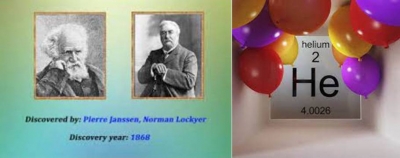
Helios, the root word from which helium was derived, refers to the Sun in Greek. This goes back to the observation of the yellow spectral lines that were given out by the chromosphere of the Sun on August 18th, 1868. Initially, Jules Janssen, the French astronomer who was studying it thought that it was caused by the element sodium. But on October 20th of the same year, an English astronomer named Norman Lockyer observed the same lines and concluded that this was caused by some other element in the Sun and named those lines as D3 Fraunhofer lines. Later, Lockyer and Edward Frankland, an English chemist, named the element as helium. The atomic number of helium is 2.
Though helium was thought to be present only in the Sun, in 1882, Italian physicist Luigi Palmieri detected it on Earth when he was analyzing the lava from Mount Vesuvius volcano. But helium was successfully isolated by Sir William Ramsay, a British chemist, while he was searching for argon. He isolated it by treating a sample of cleveite with mineral acids, and it was confirmed by Sir William Crookes and Sir Norman Lockyer. Consequently, a number of interesting properties of helium were discovered, such as the discovery that an alpha particle is actually a helium ion. This happened in 1907 through the works of Ernest Rutherford and Thomas Royds. Later, in 1908, helium gas was first liquefied by cooling it to less than one Kelvin by Heike Kamerlingh Onnes, a Dutch physicist.
In today’s world, helium is used in many industrial, commercial and recreational activities. Being lighter than air, it is used in airships and balloons to provide buoyancy during flight. It is also preferred in airships as it is non-inflammable and also fire-retarding. Helium is also used in MRI scanners and spectrometers as a coolant for the superconducting magnets in them.
Picture Credit : Google




